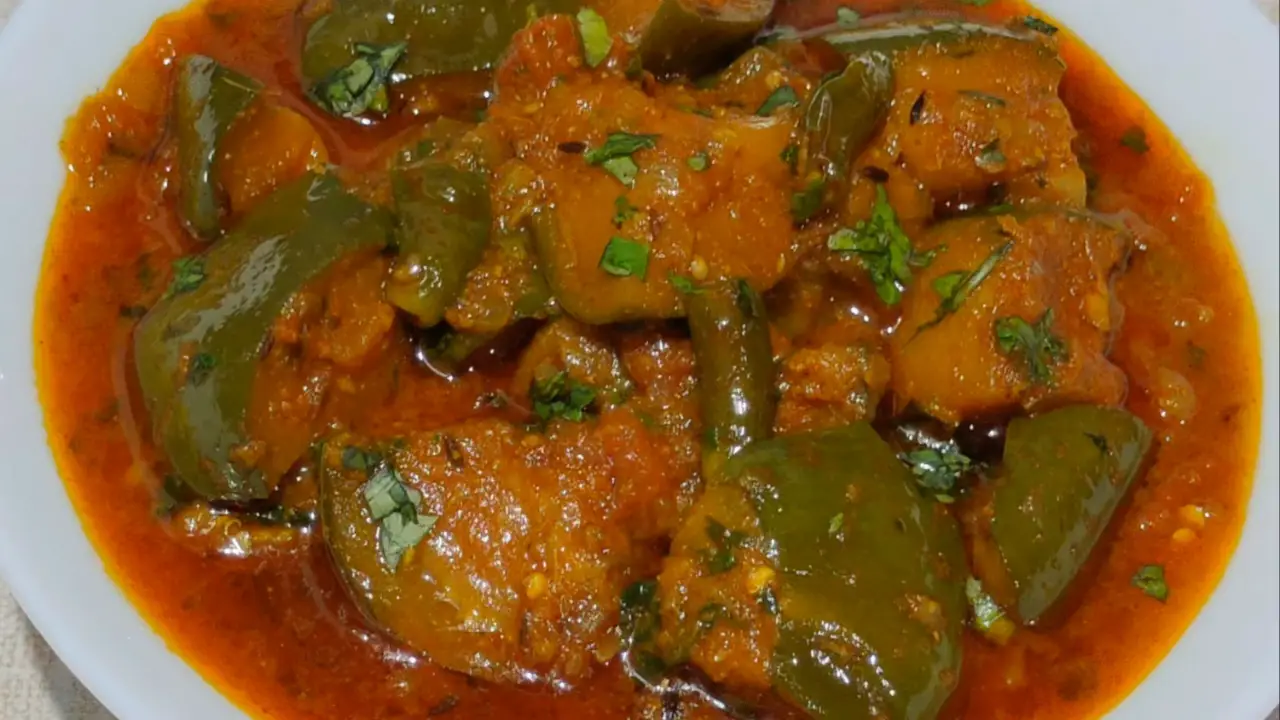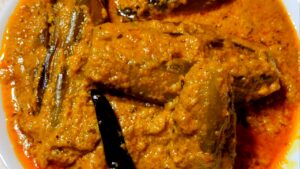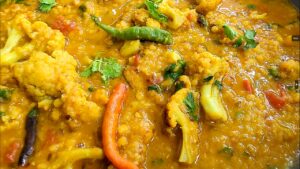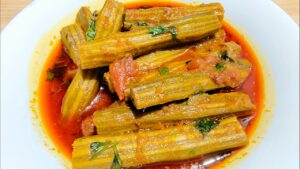Eggplant curry is a flavorful and aromatic dish made with eggplant (brinjal) cooked in a spiced gravy, often featuring ingredients like tomatoes, onions, and various spices.
When cooked properly, eggplant becomes incredibly tender and soaks up the flavors of the spices and sauce, making it a perfect choice for a curry.
This eggplant curry recipe is relatively simple to prepare and can be customized to suit your taste preferences.

Key Takeaways:
- Eggplant curry is a popular and flavorful dish enjoyed in various cuisines worldwide.
- Eggplant, also known as brinjal, is the star ingredient in this curry, known for its tender texture.
- Serve eggplant curry with options like steamed rice, paratha or roti.
- Alternatives to eggplant curry can be cauliflower, mushroom, pumpkin, potatoes, and mixed vegetable curry. You can also try palak paneer or a curry with chickpeas as a suitable alternative.
The Ingredients

- Eggplant or begun: 2 pieces (chunky cut and cleaned)
- Tomato: 1-piece big size (chopped)
- Onion: 1-piece big size (chopped)
- Coriander leaves: 2 tbsp
- Green chilis: 2 pieces
- Curry leaves: 1 tbsp
- Ginger-garlic paste: 2 tbsp
- Cumin seed: ½ tbsp
- Roasted spice powder: 2 tbsp (1 tbsp cumin seeds + 1 tbsp coriander seeds + 2 green cardamom)
- Cumin powder: ½ tbsp
- Coriander powder: ½ tbsp
- Turmeric powder: 1 tbsp
- Kashmiri red chili powder: 1 tbsp
- Red chili powder: 1 tbsp
- Salt to taste
- Mustard oil: 3 tbsp
How to Cook Eggplant Curry (Step by Step Images)?
1. Add 3 tbsp of mustard oil to the wok and heat it up. Put in the cumin seeds and curry leaves, then sauté everything for 2 seconds.
(Pro tip: Add oil according to your preference.)

2. When the curry leaves and cumin seeds are fried, add the chopped onions. Stir until they turn a light brown color.

3. Add the chopped tomatoes once the onions are fried. Then sauté everything for 10 seconds until it becomes dry.

4. Add the green chilis. Break and add them to the spice mixture. Add the ginger-garlic paste and stir-fry for 1 minute until the raw smell dissipates.

5. As soon as the raw smell from the ginger-garlic paste dissipates, add the powdered spices: turmeric powder, Kashmiri red chili powder, cumin powder, coriander powder, and red chili powder.

6. Add 2 tsp of salt and mix well. Now add a little water to cook the spices. Stir well until the raw smell dissipates.

7. After 1 minute of stirring the spices, add the eggplant pieces and mix thoroughly.

8. When the stirring is done for 1 min, add 1 cup of water. Mix well, then cover.

9. After a few minutes of cooking, it is done. Sprinkle coriander leaves and roasted spices, and mix everything well. Turn off the flame.

10. Transfer the Eggplant Curry to a bowl. Serve it with steamed rice, or Indian flatbread like paratha, roti or chapati.
Recipe Card:
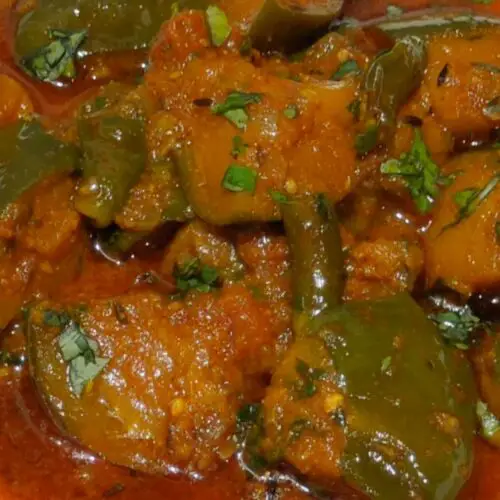
Eggplant Curry (Baingan Curry)
Ingredients
- 2 pieces Eggplant (chunky cut and cleaned)
- 1 piece Tomato (chopped)
- 1 piece Onion (chopped)
- 2 tbsp Coriander leaves
- 2 pieces Green chili
- 1 tbsp Curry leaves
- 2 tbsp Ginger-garlic paste
- ½ tbsp Cumin seed
- 2 tbsp Roasted spice powder (1 tbsp cumin seeds + 1 tbsp coriander seeds + 2 green cardamom)
- ½ tbsp Cumin powder
- ½ tbsp Coriander powder
- 1 tbsp Turmeric powder
- 1 tbsp Kashmiri red chili powder
- 1 tbsp Red chili powder
- 3 tbsp Mustard oil
- Salt to taste
Instructions
- Add 3 tbsp of mustard oil to the wok and heat it up. Put in the cumin seeds and curry leaves, then sauté everything for 2 seconds.(Pro tip: Add oil according to your preference.)
- When the curry leaves and cumin seeds are fried, add the chopped onions. Stir until they turn a light brown color.
- Add the chopped tomatoes once the onions are fried. Then sauté everything for 10 seconds until it becomes dry.
- Add the green chilis. Break and add them to the spice mixture. Add the ginger-garlic paste and stir-fry for 1 minute until the raw smell dissipates.
- As soon as the raw smell from the ginger-garlic paste dissipates, add the powdered spices: turmeric powder, Kashmiri red chili powder, cumin powder, coriander powder, and red chili powder.
- Add 2 tsp of salt and mix well. Now add a little water to cook the spices. Stir well until the raw smell dissipates.
- After 1 minute of stirring the spices, add the eggplant pieces and mix thoroughly.
- When the stirring is done for 1 min, add 1 cup of water. Mix well, then cover.
- After a few minutes of cooking, it is done. Sprinkle coriander leaves and roasted spices, and mix everything well. Turn off the flame.
- Transfer the Eggplant Curry to a bowl. Serve it with steamed rice, or Indian flatbreads like paratha, roti or chapati.
Video
Notes
- I use fresh eggplants to make this dish. Select small, young eggplants with a smooth skin and no blemishes for a better texture. Mature eggplants are bitter. If you use them make sure you soak the pieces in salt water and drain it to remove additional bitterness.
- Cut the eggplants into uniform pieces. This will ensure even cooking. Add a little bit of salt and keep aside for some time.
- You may alter the spice level according to your choice. Ensure to dry roast the whole spices in a pan. This will help release the natural oils and add to the aroma.
- The recipe is customizable. You can add tamarind, tomato, and even coconut milk or yogurt if you wish to. This will give your dish a distinct flavor and texture.
- Regulate the flame of your gas stove to simmer the curry slowly. This will help the flavor meld and fuse perfectly to add to the taste.

